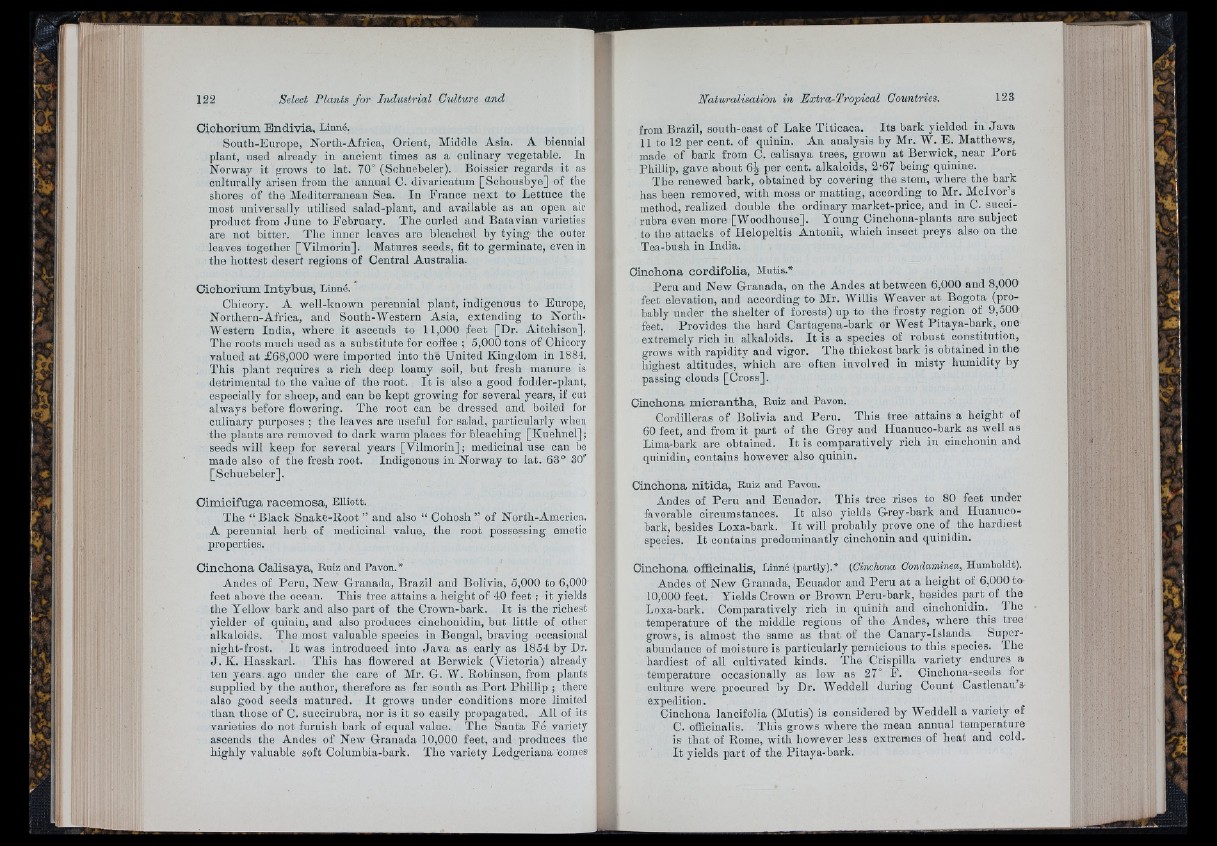
I. : r
C ic h o r ium B n d iv ia . Linné.
South-Europe, North-Africa, Orient, Middle Asia. A biennial
plant, used already in ancient times as a culinary vegetable. In
Norway it grows to lat. 70° (Schuebeler). Boissier regards it as
culturally arisen from the annual C. divaricatum [Schousbye] of the
shores of the Mediterranean Sea. In France next to Lettuce the
most universally utilised salad-plant, and available as an open air
product from Ju n e to February. The curled and Batavian varieties
are not bitter. Tlie inner leaves are bleached by tying the outer
leaves together [Vilmorin]. Matures seeds, fit to germinate, even in
the hottest desert regions of Central Australia.
C ic h o r ium I n t y b u s , Linné.
Chicory. A well-known perennial plant, indigenous to Europe,
Northern-Africa, and South-Western Asia, extending to North-
Western India, where it ascends to 11,000 feet [Dr. Aitchison],
The roots much used as a substitute for coffee ; 5,000 tons of Chicory
valued a t £68,000 were imported into the United Kingdom in 1884.
This plant requires a rich deep loamy soil, but fresh manure is
detrimental to the value of the root. I t is also a good fodder-plaut,
especially for sheep, aud can be kept growing for several years, if out
always before flowering. The root can be dressed and boiled for
culinary purposes ; the leaves are useful for salad, particularly when
the plants are removed to dark warm places for Bleaching [Knehnel] ;
seeds will keep for several years [Vilmorin]; medicinal use can be
made also of the fresh root. Indigenous iu Norway to lat. 63° 30"
[Schuebeler].
C im ic ifu g a r a c em o s a , Elliott.
The “ Black Snake-Root ” and also “ Cohosh ” of North-America.
A perennial herb of medicinal value, the root possessing emetic
properties.
C in c h o n a C a lis a y a , Ruiz and Pavon. *
Andes of Peru, New Granada, Brazil and Bolivia, 5,000 to 6,000
feet above the ocean. This tree attains a height of 40 feet ; it yields
the Yellow bark and also part of the Crown-bark. I t is the richest
yielder of qniniu, and also produces cinchonidin, but little of otlier
alkaloids. The most valuable species in Bengal, braving occasional
night-frost. I t was introduced into J a v a as early as 1854 by Dr.
J . K. Hasskarl. This has flowered at Berwick (Victoria) already
ten years ago under the care ot Mr. G. W. Robinson, from plants
supplied by the author, therefore as far south as Po rt Phillip ; there
also good seeds matured. I t grows under conditions more limited
than those of C. suocirubra, nor is it so easily propagated. All of its
varieties do not furnish bark of equal value. The Santa Fc variety
ascends the Andes of New Granada 10,000 feet, and produces the
highly valuable soft Columbia-bark. The variety Ledgeriana 'comes
from Brazil, south-east of Lake Tilicaca. Its bark yielded in Jav a
11 to 12 per cent, of quinin. An analysis by Mr. W. E. Matthews,
made of bark from C. calisaya trees, grown a t Berwick, near P o rt
Phillip, gave about 6^ per cent, alkaloids, 2'67 being quinine.
The renewed bark, obtained by covering the stem, where the bark
has been removed, with moss or matting, aecording to Mr. Molvor’s
method, realized double the ordinary market-price, and in C. succirubra
even more [Woodhouse]. Young Cinchona-plants are subject
to the attacks of Helopeltis Antonii, which insect preys also on the
Tea-bush in India.
Oin o h o n a c o rd ifo lia , Mutis.'*
Peru and New Granada, on the Andes a t between 6,000 and 8,000
feet elevation, and according to Mr. Willis Weaver at Bogota (probably
under the shelter of forests) up to the frosty region of 9,500
feet. Provides the hard Cartagena-bark or West Pitaya-bark, one
extremely rich in alkaloids. I t is a species of robust constitution,
grows with rapidity and vigor. The thickest bark is obtained in the
highest altitudes, which are often involved in misty humidity by
passing clouds [Cross].
Cinoliona m io r a n th a , Ruiz and Pavon.
Cordilleras of Bolivia and Peru. This tree attains a height of
60 feet, and from it part of the Grey and Huanuco-bark as well as
Lima-bark are obtained. I t is comparatively rich in cinchonin and
quinidin, contains however also quinin.
C in c h o n a n i tid a , Ruiz and Pavon.
Andes of Peru and Ecuador. This tree rises to 80 feet under
favorable circumstances. I t also yields Grey-bark and Huanuco-
bark, besides Loxa-bark. I t will probably prove one of the hardiest
species. I t contains predominantly cinchonin and quinidin.
C in c h o n a o fflc in a lis , Linné (partly).* (Ci-nchoHa Gondaminea, Humboldt).
Andes of New Granada, Ecuador and Peru a t a height of 6,000 to
10,000 feet. Yields Crown or Brown Perii-bark, besides part of the
Loxa-bark. Comparatively rich in quinin and cinchonidin. I he
temperature of the middle regions of the Andes, where this tree
grows, is almost the same as th a t of the Canary-Islands. Superabundance
of moisture is partioularly pernicious to this species. Ih e
hardiest of all cultivated kinds. The Crispilla variety endures a
temperature occasionally as low as 27° E. Cinchona-seeds for
culture were procured by Dr. Weddell during Count Castlenau 3-
expedition.
Cinchona lancifolia (Mutis) is considered by Weddell a variety of
C. officinalis. This grows where the mean annual temperature
is th a t of Rome, with however less extremes of heat and cold.
I t yields part of the Pitaya-bark.